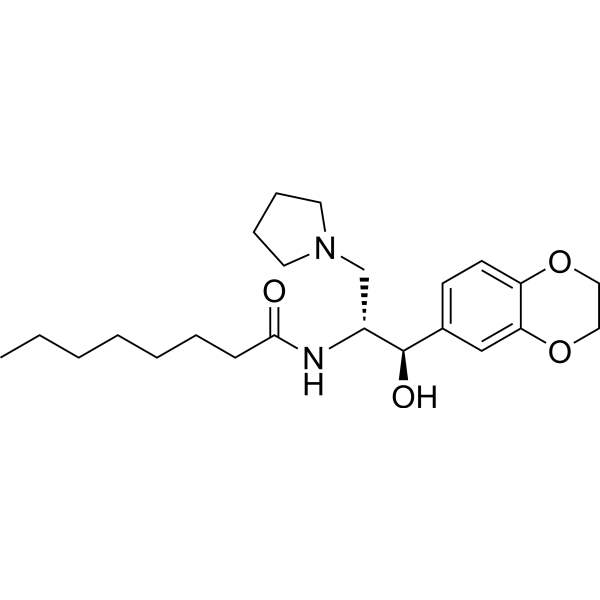| Cas No.: | 491833-29-5 |
| Chemical Name: | Eliglustat free base |
| Synonyms: | ELIGLUSTAT;Octanamide,N-[(1R,2R)-2-(2,3-dihydro-1,4-benzodioxin-6-yl)-2-hydroxy-1-(1-pyrrolidinylmethyl)ethyl]-;N-[(1R,2R)-1-(2,3-dihydro-1,4-benzodioxin-6-yl)-1-hydroxy-3-pyrrolidin-1-ylpropan-2-yl]octanamide;Octanamide, N-[(1R,2R)-2-(2,3-dihydro-1,4-benzodioxin-6-yl)-2-hydroxy-1-(1-pyrrolid inylmethyl)ethyl]-;Eliglustat [USAN:INN];Genz 112638;Genz 99067;GENZ-112638;Genz-99067;SureCN421755;UNII-DR40J4WA67;N-[(1R,2R)-2-(2,3-Dihydro-1,4-benzodioxin-6-yl)-2-hydroxy-1-(1-pyrrolidinylmethyl)ethyl]-octanamide |
| SMILES: | CCCCCCCC(N[C@H](CN1CCCC1)[C@@H](C2=CC=C(OCCO3)C3=C2)O)=O |
| Formula: | C23H36N2O4 |
| M.Wt: | 404.551 |
| Purity: | >98% |
| Sotrage: | 2 years -20°C Powder, 2 weeks 4°C in DMSO, 6 months -80°C in DMSO |
| Description: | Eliglustat is an specific, potent and orally active glucocerebroside synthase inhibitor with an IC50 of 24 nM. |
| In Vivo: | Mice that received drug prior to significant accumulation of substrate (10 weeks of age) showed reduced levels of glucosylceramide and number of Gaucher cells in the spleen, lung and liver when compared to age-matched control animals[1]. |
| In Vitro: | Eliglustat tartrate shows good potency with an IC50 of 24 nM and specificity against the target enzyme[1].Incubating K562 or B16/F10 cells for 72 h with increasing amounts of Genz-112638 (0.6-1000 nM) results in a dose-dependent reduction of cell surface levels of both GM1 and GM3. The mean IC50 value for inhibiting the cell surface presentation of GM1 in K562 cells was 24 nM (range 14-34 nM) and that for GM3 in B16/F10 cells was 29 nM (range 12-48 nM)[1]. |
| Cell Assay: | The inhibitory activity of Genz-112638 is determined indirectly by measuring its effect on the cell surface levels of the gangliosides GM1 and GM3 on either K562 or B16/F10 cells. GM1 levels on the K562 cells are determined by incubating the cells with increasing amounts of Genz-112638 (0.6-1000 nM) for 72 h after which the cells are harvested and stained using 10 μg of recombinant cholera toxin-FITC in 100 μL phosphate buffered saline (PBS) containing 0.5% bovine serum albumin (BSA) for 30 min on ice. Cells are ished, resuspended in PBS containing 0.5% BSA and the fluorescence quantitated[1]. |
| Animal Administration: | Mice: Eliglustat hemitartrate is dissolved in water for injection and administered in a dose escalation from 75 mg/kg/day to 150 mg/kg/day over the course of nine days, with three days at each dose and increments of 25 mg/kg/day. Mice are weighed three times per week to monitor the potential impact of the drug on their overall health. Animals are killed by carbon dioxide inhalation[1]. |
| References: | [1]. McEachern KA, et al. A specific and potent inhibitor of glucosylceramide synthase for substrate inhibition therapy ofGaucher disease. Mol Genet Metab. 2007 Jul;91(3):259-68. |

 DC Chemicals' products qualify for U.S. tariff exemptions. We guarantee no price increases due to customs duties and maintain stable supply, continuing to deliver reliable research solutions to our American clients.
DC Chemicals' products qualify for U.S. tariff exemptions. We guarantee no price increases due to customs duties and maintain stable supply, continuing to deliver reliable research solutions to our American clients.





















